Computer Networks: A Systems Approach
Fifth Edition
Solutions Manual
Larry Peterson and Bruce Davie
2011
1
�
Dear Instructor:
This Instructors’ Manual contains solutions to most of the exercises in the fifth edition
of Peterson and Davie’s Computer Networks: A Systems Approach.
Exercises are sorted (roughly) by section, not difficulty. While some exercises are
more difficult than others, none are intended to be fiendishly tricky. A few exercises
(notably, though not exclusively, the ones that involve calculating simple probabilities)
require a modest amount of mathematical background; most do not. There is a sidebar
summarizing much of the applicable basic probability theory in Chapter 2.
An occasional exercise is awkwardly or ambiguously worded in the text. This manual
sometimes suggests better versions; also see the errata at the web site.
Where appropriate, relevant supplemental files for these solutions (e.g. programs) have
been placed on the textbook web site, http://mkp.com/computer-networks.
Useful other material can also be found there, such as errata, sample programming
assignments, PowerPoint lecture slides, and EPS figures.
If you have any questions about these support materials, please contact your Morgan
Kaufmann sales representative.
If you would like to contribute your own teaching
materials to this site, please contact our Associate Editor David Bevans,
D.Bevans@elsevier.com.
We welcome bug reports and suggestions as to improvements for both the exercises
and the solutions; these may be sent to netbugsPD5e@elsevier.com.
Larry Peterson
Bruce Davie
March, 2011
�
Chapter1
1
Solutions for Chapter 1
3. We will count the transfer as completed when the last data bit arrives at its desti-
nation. An alternative interpretation would be to count until the last ACK arrives
back at the sender, in which case the time would be half an RTT (25 ms) longer.
(a) 2 initial RTT’s (100ms) + 1000KB/1.5Mbps (transmit) + RTT/2 (propaga-
tion = 25ms)
≈ 0.125 + 8Mbit/1.5Mbps = 0.125 + 5.333 sec = 5.458 sec. If we pay
more careful attention to when a mega is 106 versus 220, we get
8,192,000 bits/1,500,000 bps = 5.461 sec, for a total delay of 5.586 sec.
(b) To the above we add the time for 999 RTTs (the number of RTTs between
when packet 1 arrives and packet 1000 arrives), for a total of 5.586 +
49.95 = 55.536.
(c) This is 49.5 RTTs, plus the initial 2, for 2.575 seconds.
(d) Right after the handshaking is done we send one packet. One RTT after the
handshaking we send two packets. At n RTTs past the initial handshaking
we have sent 1 + 2 + 4 + ··· + 2n = 2n+1 − 1 packets. At n = 9 we have
thus been able to send all 1,000 packets; the last batch arrives 0.5 RTT later.
Total time is 2+9.5 RTTs, or .575 sec.
4. The answer is in the book.
5. Propagation delay is 4×103 m/(2×108 m/s) = 2×10−5 sec = 20 µs. 100 bytes/20 µs
is 5 bytes/µs, or 5 MBps, or 40 Mbps. For 512-byte packets, this rises to 204.8 Mbps.
6. The answer is in the book.
7. Postal addresses are strongly hierarchical (with a geographical hierarchy, which
network addressing may or may not use). Addresses also provide embedded
“routing information”. Unlike typical network addresses, postal addresses are
long and of variable length and contain a certain amount of redundant informa-
tion. This last attribute makes them more tolerant of minor errors and inconsis-
tencies. Telephone numbers, at least those assigned to landlines, are more sim-
ilar to network addresses: they are (geographically) hierarchical, fixed-length,
administratively assigned, and in more-or-less one-to-one correspondence with
nodes.
8. One might want addresses to serve as locators, providing hints as to how data
should be routed. One approach for this is to make addresses hierarchical.
Another property might be administratively assigned, versus, say, the factory-
assigned addresses used by Ethernet. Other address attributes that might be
relevant are fixed-length v. variable-length, and absolute v. relative (like file
names).
�
Chapter1
2
If you phone a toll-free number for a large retailer, any of dozens of phones may
answer. Arguably, then, all these phones have the same non-unique “address”. A
more traditional application for non-unique addresses might be for reaching any
of several equivalent servers (or routers). Non-unique addresses are also useful
when global reachability is not required, such as to address the computers within
a single corporation when those computers cannot be reached from outside the
corporation.
9. Video or audio teleconference transmissions among a reasonably large number
of widely spread sites would be an excellent candidate: unicast would require a
separate connection between each pair of sites, while broadcast would send far
too much traffic to sites not interested in receiving it. Delivery of video and audio
streams for a television channel only to those households currently interested in
watching that channel is another application.
Trying to reach any of several equivalent servers, each of which can provide the
answer to some query, would be another possible use, although the receiver of
many responses to the query would need to deal with the possibly large volume
of responses.
10. STDM and FDM both work best for channels with constant and uniform band-
width requirements. For both mechanisms bandwidth that goes unused by one
channel is simply wasted, not available to other channels. Computer communi-
cations are bursty and have long idle periods; such usage patterns would magnify
this waste.
FDM and STDM also require that channels be allocated (and, for FDM, be as-
signed bandwidth) well in advance. Again, the connection requirements for com-
puting tend to be too dynamic for this; at the very least, this would pretty much
preclude using one channel per connection.
FDM was preferred historically for TV/radio because it is very simple to build
receivers; it also supports different channel sizes. STDM was preferred for voice
because it makes somewhat more efficient use of the underlying bandwidth of
the medium, and because channels with different capacities was not originally
an issue.
11. 10 Gbps = 1010 bps, meaning each bit is 10−10 sec (0.1 ns) wide. The length in
the wire of such a bit is .1 ns × 2.3 × 108 m/sec = 0.023 m or 23mm
12. x KB is 8 × 1024 × x bits. y Mbps is y × 106 bps; the transmission time would
be 8 × 1024 × x/y × 106 sec = 8.192x/y ms.
(a) The minimum RTT is 2 × 385, 000, 000 m / 3×108 m/s = 2.57 seconds.
(b) The delay×bandwidth product is 2.57 s×1 Gbps = 2.57Gb = 321 MB.
(c) This represents the amount of data the sender can send before it would be
13.
possible to receive a response.
�
Chapter1
3
(d) We require at least one RTT from sending the request before the first bit
of the picture could begin arriving at the ground (TCP would take longer).
25 MB is 200Mb. Assuming bandwidth delay only, it would then take
200Mb/1000Mbps = 0.2 seconds to finish sending, for a total time of 0.2 +
2.57 = 2.77 sec until the last picture bit arrives on earth.
14. The answer is in the book.
15.
(a) Delay-sensitive; the messages exchanged are short.
(b) Bandwidth-sensitive, particularly for large files. (Technically this does pre-
sume that the underlying protocol uses a large message size or window size;
stop-and-wait transmission (as in Section 2.5 of the text) with a small mes-
sage size would be delay-sensitive.)
(c) Delay-sensitive; directories are typically of modest size.
(d) Delay-sensitive; a file’s attributes are typically much smaller than the file
itself.
16.
(a) On a 100 Mbps network, each bit takes 1/108 = 10 ns to transmit. One
packet consists of 12000 bits, and so is delayed due to bandwidth (serial-
ization) by 120 µs along each link. The packet is also delayed 10 µs on
each of the two links due to propagation delay, for a total of 260 µs.
(b) With three switches and four links, the delay is
4 × 120µs + 4 × 10µs = 520µs
(c) With cut-through, the switch delays the packet by 200 bits = 2 µs. There
is still one 120 µs delay waiting for the last bit, and 20 µs of propagation
delay, so the total is 142 µs. To put it another way, the last bit still arrives
120 µs after the first bit; the first bit now faces two link delays and one
switch delay but never has to wait for the last bit along the way.
17. The answer is in the book.
18.
(a) The effective bandwidth is 100 Mbps; the sender can send data steadily
at this rate and the switches simply stream it along the pipeline. We are
assuming here that no ACKs are sent, and that the switches can keep up
and can buffer at least one packet.
(b) The data packet takes 520 µs as in 16(b) above to be delivered; the 400 bit
ACKs take 4 µs/link to be sent back, plus propagation, for a total of 4×4 µs
+4 × 10 µs = 56 µs; thus the total RTT is 576 µs. 12000 bits in 576 µs is
about 20.8 Mbps.
(c) 100×4.7×109 bytes / 12 hours = 4.7×1011 bytes/(12×3600 s) ≈ 10.9 MBps
= 87 Mbps.
19.
(a) 100×106bps × 10 × 10−6 sec = 1000 bits = 125 bytes.
�
Chapter1
4
(b) The first-bit delay is 520 µs through the store-and-forward switch, as in
16(a). 100 × 106bps × 520×10−6 sec = 52000 bits = 650 bytes.
(c) 1.5×106 bps × 50 × 10−3 sec = 75,000 bits = 9375 bytes.
(d) The path is through a satellite, i.e. between two ground stations, not to
a satellite; this ground-to-satellite-to-ground path makes the total one-way
travel distance 2×35,900,000 meters. With a propagation speed of c =
3×108 meters/sec, the one-way propagation delay is thus 2×35,900,000/c
= 0.24 sec. Bandwidth×delay is thus 1.5 × 106 bps × 0.24 sec = 360,000
bits ≈ 45 KBytes
(a) Per-link transmit delay is 104 bits / 108 bps = 100 µs. Total transmission
time including link and switch propagation delays = 2×100+2×20+35 =
275 µs.
(b) When sending as two packets, the time to transmit one packet is cut in half.
20.
Here is a table of times for various events:
start
A finishes sending packet 1, starts packet 2
packet 1 finishes arriving at S
packet 1 departs for B
T=0
T=50
T=70
T=105
T=100 A finishes sending packet 2
T=155
T=175
T=225
packet 2 departs for B
bit 1 of packet 2 arrives at B
last bit of packet 2 arrives at B
This is smaller than the answer to part (a) because packet 1 starts to make
its way through the switch while packet 2 is still being transmitted on the
first link, effectively getting a 50 µs head start. Smaller is faster, here.
21.
(a) Without compression the total time is 1 MB/bandwidth. When we com-
press the file, the total time is
compression time + compressed size/bandwidth
Equating these and rearranging, we get
bandwidth = compression size reduction/compression time
= 0.5 MB/1 sec = 0.5 MB/sec for the first case,
= 0.6 MB/2 sec = 0.3 MB/sec for the second case.
(b) Latency doesn’t affect the answer because it would affect the compressed
and uncompressed transmission equally.
22. The number of packets needed, N , is ⌈106/D⌉, where D is the packet data size.
Given that overhead = 50×N and loss = D (we have already counted the lost
packet’s header in the overhead), we have overhead+loss = 50 × ⌈106/D⌉ + D.
D overhead+loss
51000
15000
22500
1000
10000
20000
�
Chapter1
5
The optimal size is 10,000 bytes which minimizes the above function.
23. Comparison of circuits and packets result as follows :
(a) Circuits pay an up-front penalty of 1024 bytes being sent on one round trip
for a total data count of 2048 + n, whereas packets pay an ongoing per
packet cost of 24 bytes for a total count of 1024× n/1000. So the question
really asks how many packet headers does it take to exceed 2048 bytes,
which is 86. Thus for files 86,000 bytes or longer, using packets results in
more total data sent on the wire.
(b) The total transfer latency for packets is the sum of the transmit delays,
where the per-packet transmit time t is the packet size over the bandwidth b
(8192/b), introduced by each of s switches (s × t), total propagation delay
for the links ((s + 2)× 0.002), the per packet processing delays introduced
by each switch (s×0.001), and the transmit delay for all the packets, where
the total packet count c is n/1000, at the source (c × t). Resulting in a
total latency of (8192s/b) + 0.003s + 0.004 + (8.192n/b) = (0.02924 +
0.000002048n) seconds. The total latency for circuits is the transmit delay
for the whole file (8n/b), the total propagation delay for the links, and the
setup cost for the circuit which is just like sending one packet each way
on the path. Solving the resulting inequality 0.02924 + 8.192(n/b) >
0.076576 + 8(n/b) for n shows that circuits achieve a lower delay for files
larger than or equal to 987,000 B.
(c) Only the payload to overhead ratio size effects the number of bits sent,
and there the relationship is simple. The following table show the latency
results of varying the parameters by solving for the n where circuits become
faster, as above. This table does not show how rapidly the performance
diverges; for varying p it can be significant.
s
5
6
7
8
9
10
5
5
5
5
5
5
5
b
4 Mbps
4 Mbps
4 Mbps
4 Mbps
4 Mbps
4 Mbps
1 Mbps
2 Mbps
8 Mbps
16 Mbps
4 Mbps
4 Mbps
4 Mbps
p
1000
1000
1000
1000
1000
1000
1000
1000
1000
1000
512
768
1014
pivotal n
987000
1133000
1280000
1427000
1574000
1721000
471000
643000
1674000
3049000
24000
72000
2400000
(d) Many responses are probably reasonable here. The model only considers
the network implications, and does not take into account usage of process-
ing or state storage capabilities on the switches. The model also ignores
the presence of other traffic or of more complicated topologies.
�
Chapter1
6
24. The time to send one 12000-bit packet is 12000 bits/100 Mbps = 120 µs. The
length of cable needed to exactly contain such a packet is 120 µs × 2×108 m/sec
= 24,000 meters.
12000 bits in 24000 meters is 50 bits per 100 m. With an extra 10 bits of delay in
each 100 m, we have a total of 60 bits/100 m or 0.6 bits/m. A 12000-bit packet
now fills 12000/(.6 bits/m) = 20,000 meters.
25. For music we would need considerably more bandwidth, but we could toler-
ate high (but bounded) delays. We could not necessarily tolerate higher jitter,
though; see Section 6.5.1.
We might accept an audible error in voice traffic every few seconds; we might
reasonably want the error rate during music transmission to be a hundredfold
smaller. Audible errors would come either from outright packet loss, or from
jitter (a packet’s not arriving on time).
Latency requirements for music, however, might be much lower; a several-
second delay would be inconsequential. Voice traffic has at least a tenfold faster
requirement here.
(a) 640 × 480 × 3 × 30 bytes/sec = 26.4 MB/sec
(b) 160 × 120 × 1 × 5 = 96,000 bytes/sec = 94KB/sec
(c) 650MB/75 min = 8.7 MB/min = 148 KB/sec
(d) 8 × 10 × 72 × 72 pixels = 414,720 bits = 51,840 bytes. At 14,400 bits/sec,
this would take 28.8 seconds (ignoring overhead for framing and acknowl-
edgments).
26.
27. The answer is in the book.
28.
(a) A file server needs lots of peak bandwidth. Latency is relevant only if
it dominates bandwidth; jitter and average bandwidth are inconsequential.
No lost data is acceptable, but without real-time requirements we can sim-
ply retransmit lost data.
(b) A print server needs less bandwidth than a file server (unless images are
extremely large). We may be willing to accept higher latency than (a), also.
(c) A file server is a digital library of a sort, but in general the world wide web
gets along reasonably well with much less peak bandwidth than most file
servers provide.
(d) For instrument monitoring we don’t care about latency or jitter. If data were
continually generated, rather than bursty, we might be concerned mostly
with average bandwidth rather than peak, and if the data really were routine
we might just accept a certain fraction of loss.
(e) For voice we need guaranteed average bandwidth and bounds on latency
resulting in minor
and jitter. Some lost data might be acceptable; e.g.
dropouts many seconds apart.
�
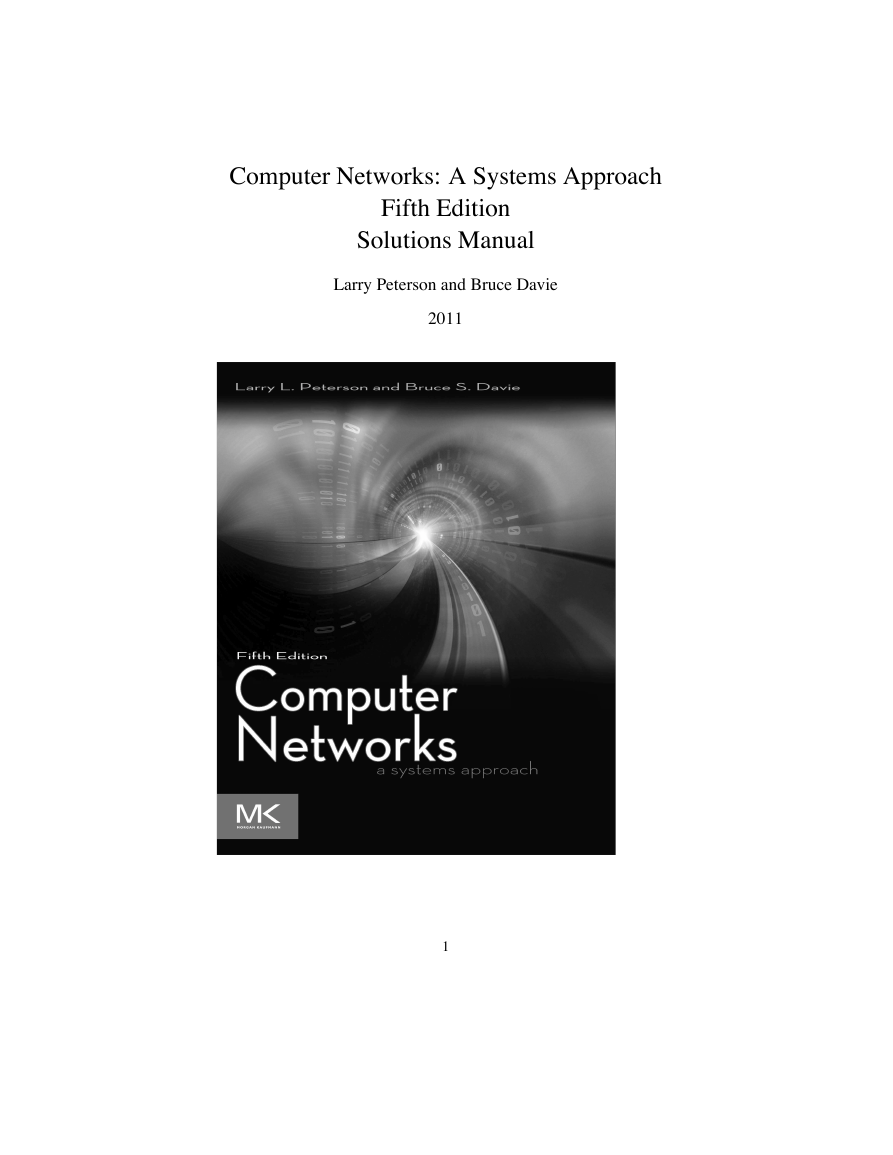
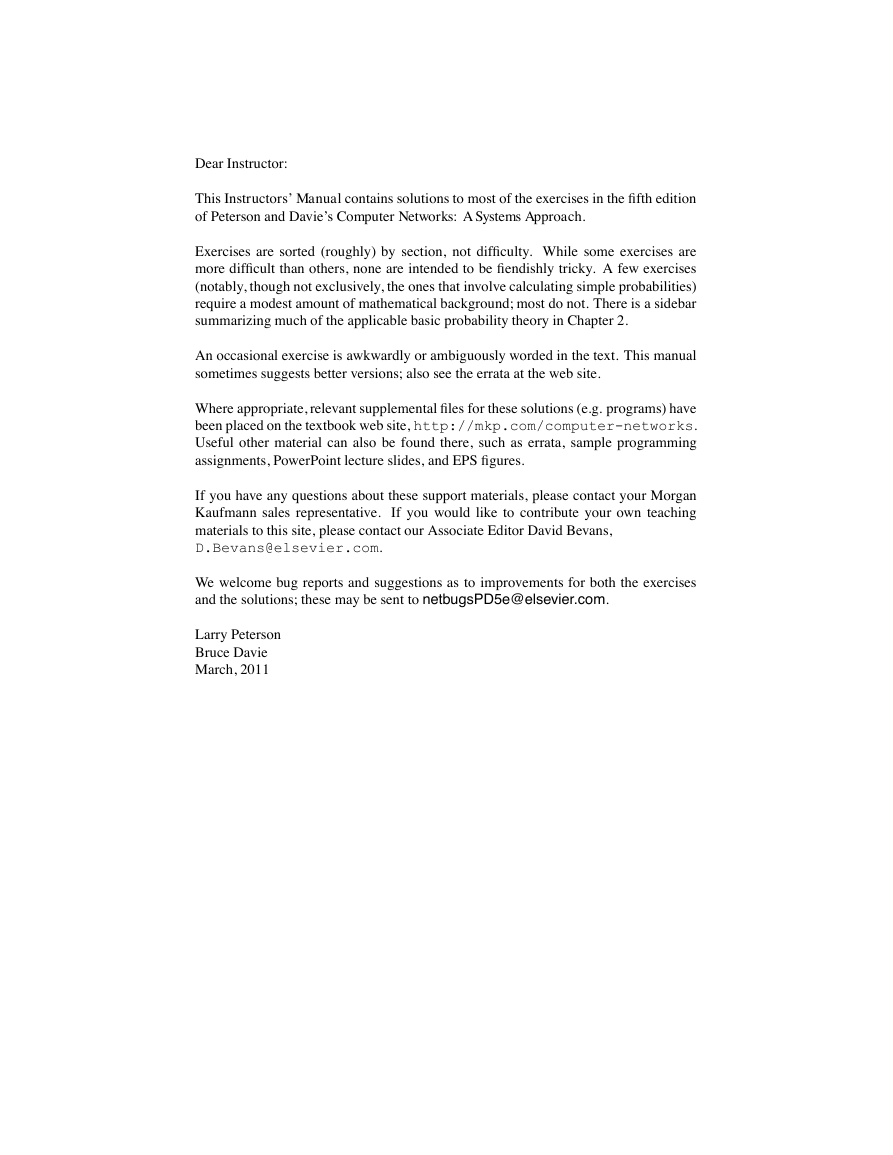
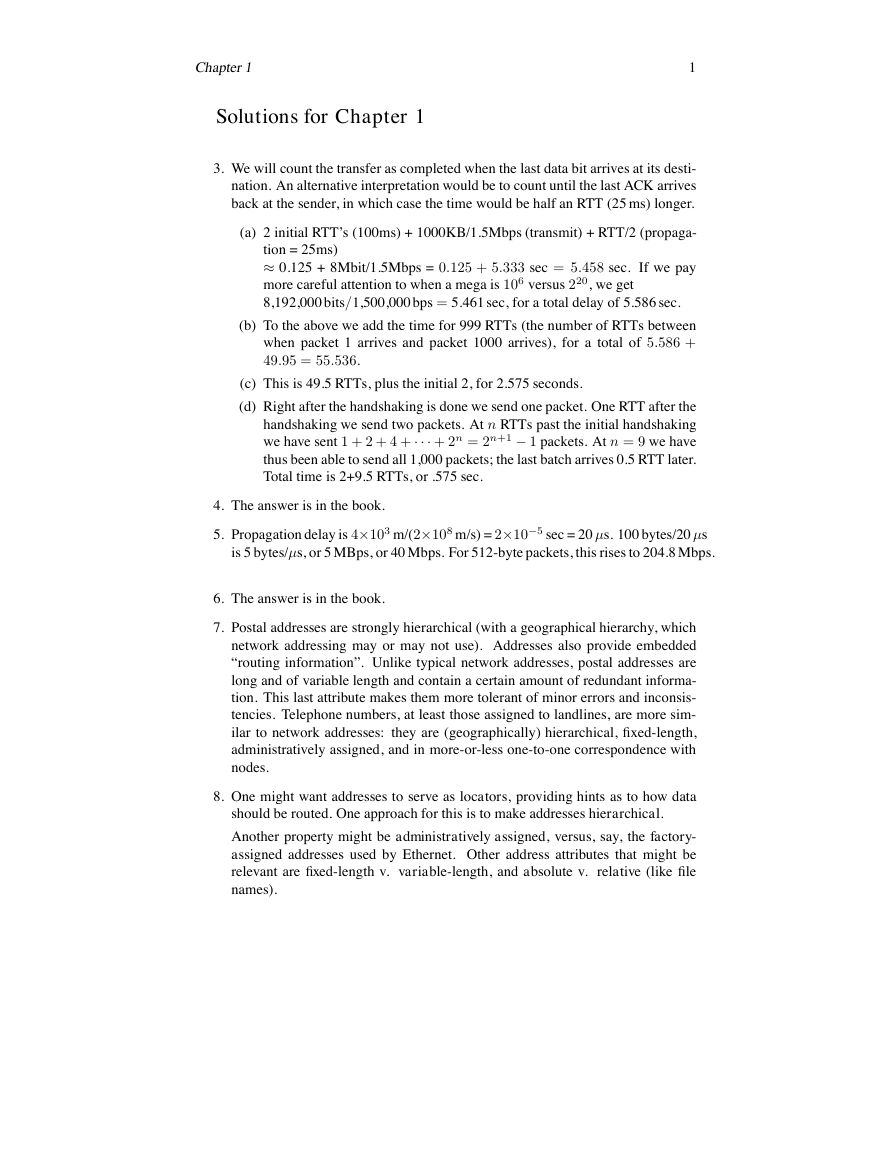
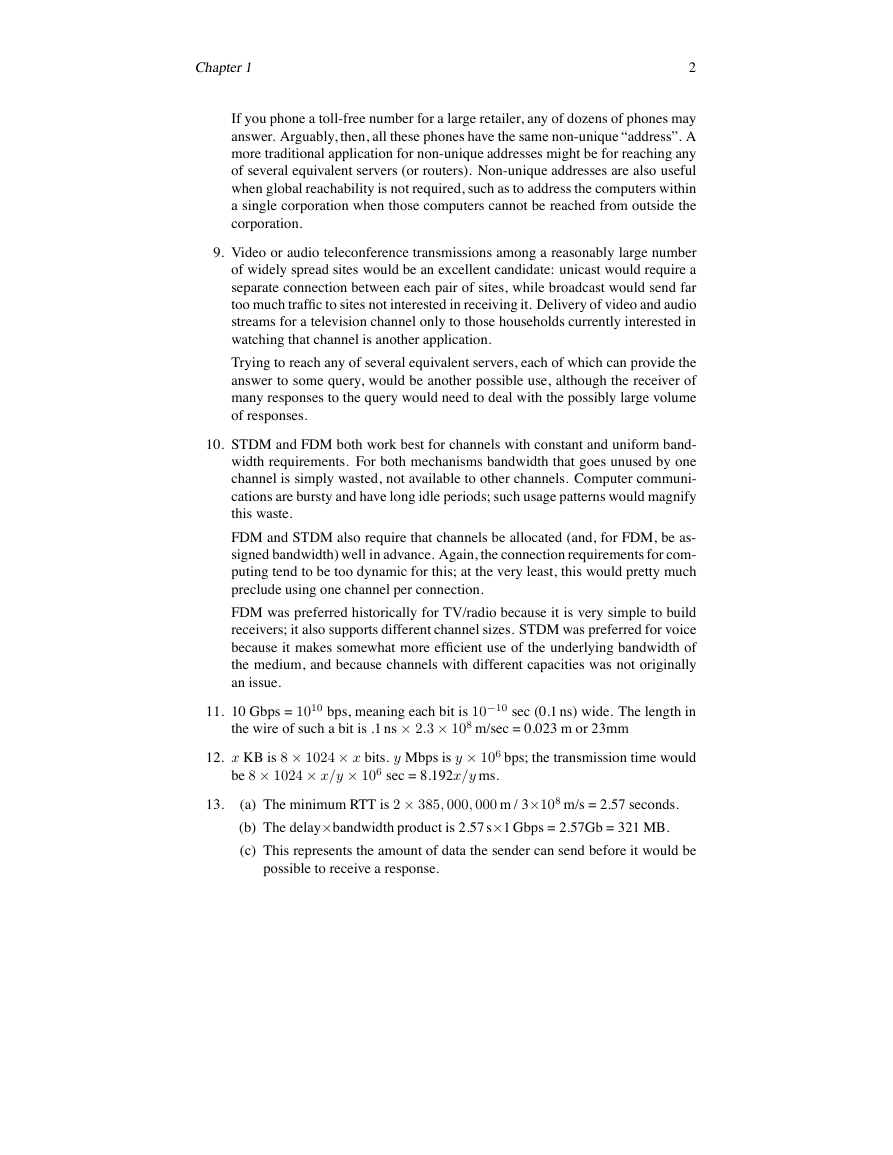
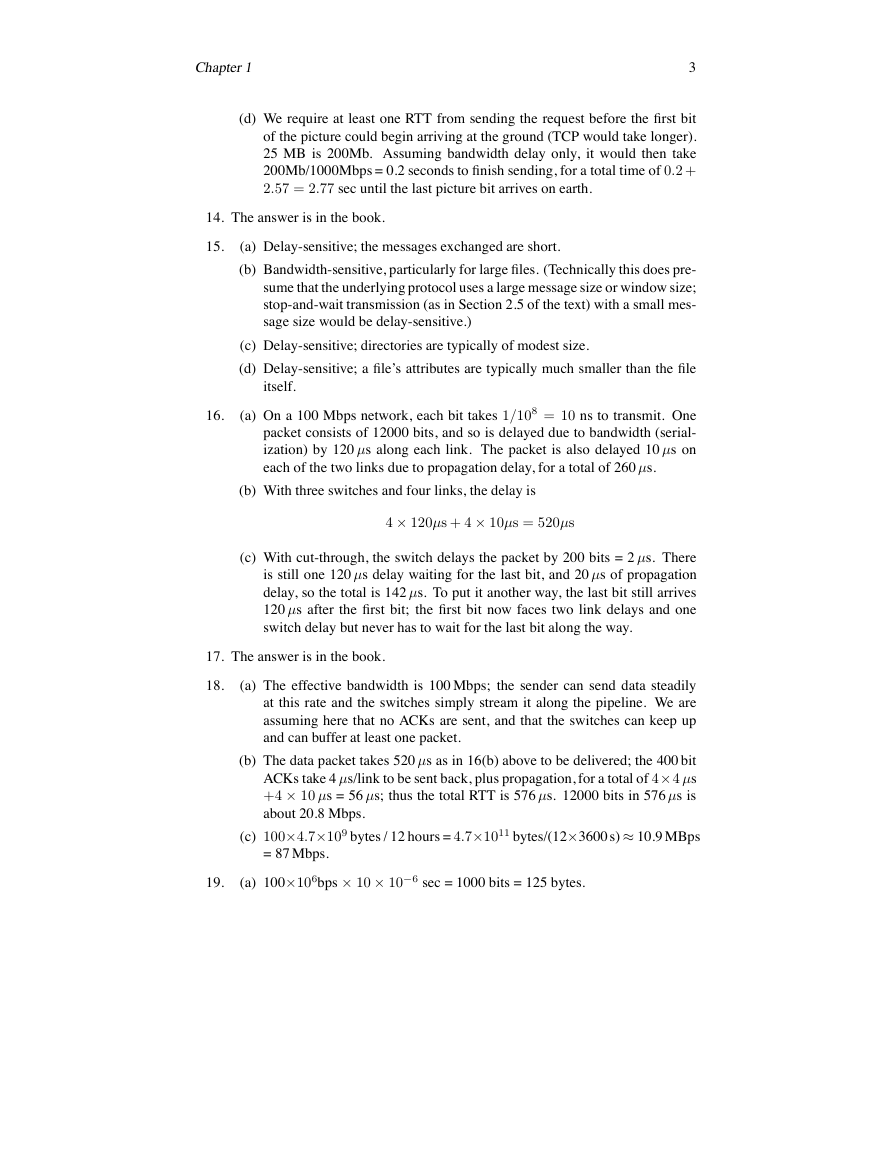
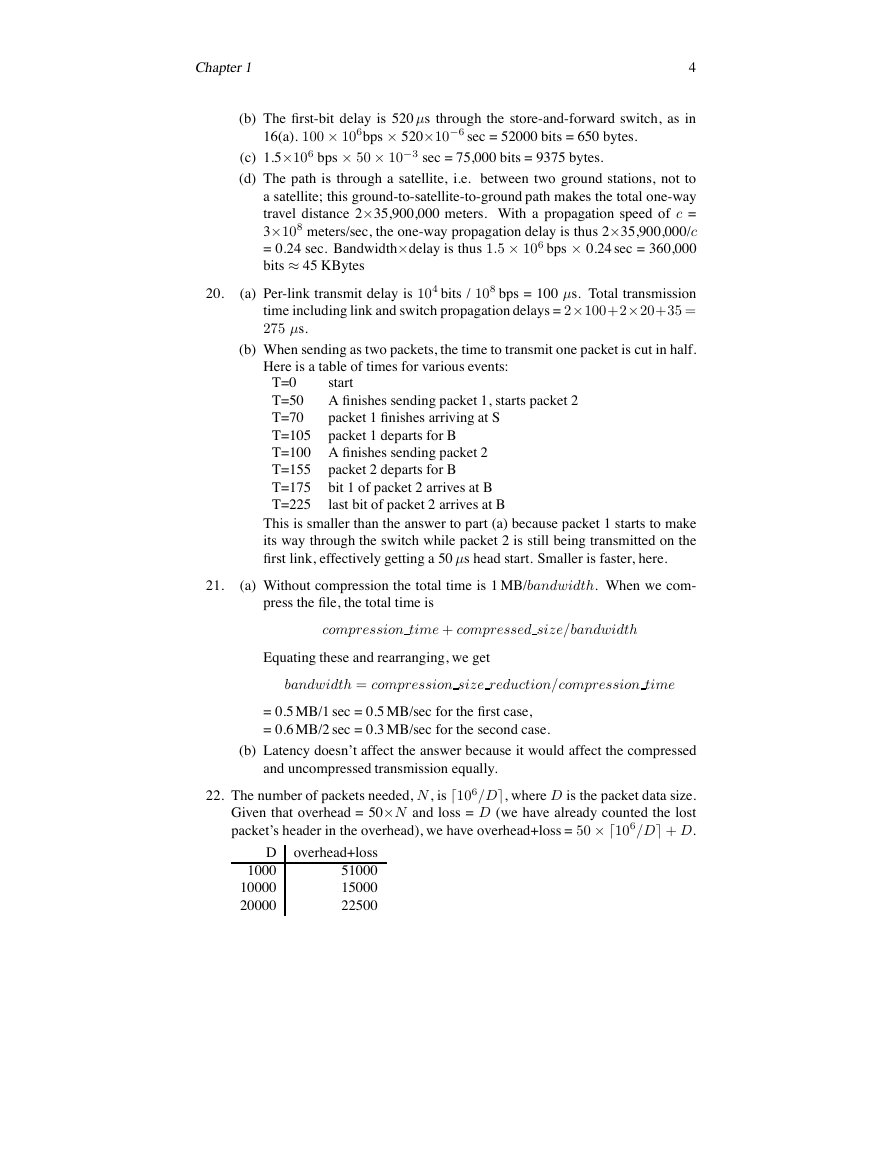
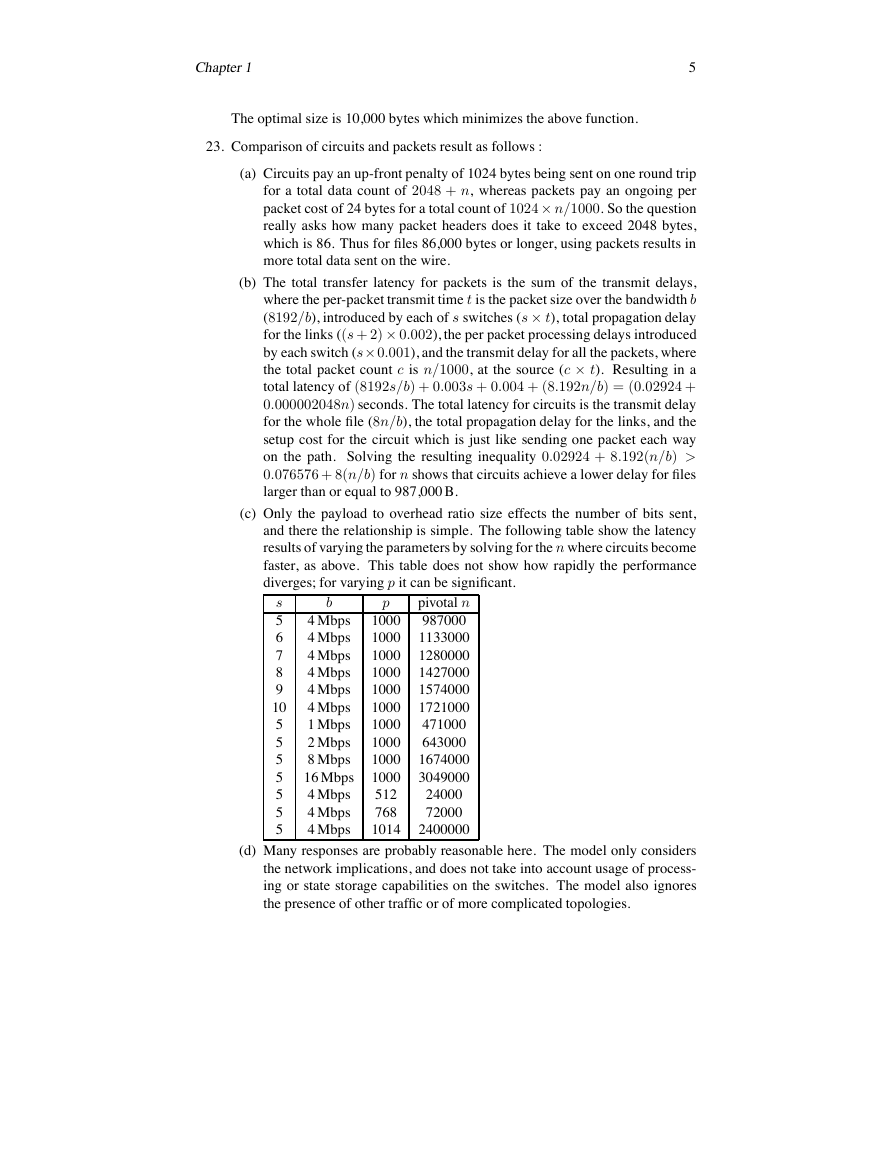
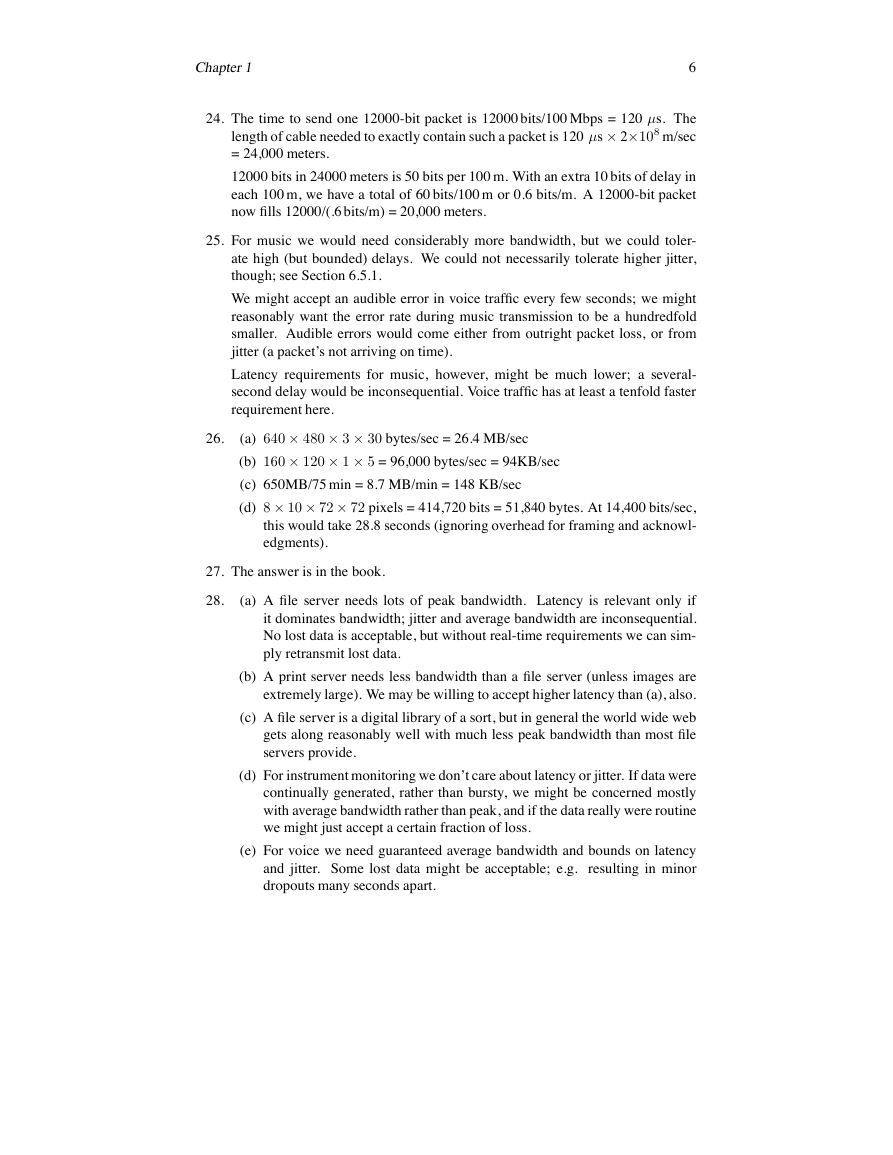








 2023年江西萍乡中考道德与法治真题及答案.doc
2023年江西萍乡中考道德与法治真题及答案.doc 2012年重庆南川中考生物真题及答案.doc
2012年重庆南川中考生物真题及答案.doc 2013年江西师范大学地理学综合及文艺理论基础考研真题.doc
2013年江西师范大学地理学综合及文艺理论基础考研真题.doc 2020年四川甘孜小升初语文真题及答案I卷.doc
2020年四川甘孜小升初语文真题及答案I卷.doc 2020年注册岩土工程师专业基础考试真题及答案.doc
2020年注册岩土工程师专业基础考试真题及答案.doc 2023-2024学年福建省厦门市九年级上学期数学月考试题及答案.doc
2023-2024学年福建省厦门市九年级上学期数学月考试题及答案.doc 2021-2022学年辽宁省沈阳市大东区九年级上学期语文期末试题及答案.doc
2021-2022学年辽宁省沈阳市大东区九年级上学期语文期末试题及答案.doc 2022-2023学年北京东城区初三第一学期物理期末试卷及答案.doc
2022-2023学年北京东城区初三第一学期物理期末试卷及答案.doc 2018上半年江西教师资格初中地理学科知识与教学能力真题及答案.doc
2018上半年江西教师资格初中地理学科知识与教学能力真题及答案.doc 2012年河北国家公务员申论考试真题及答案-省级.doc
2012年河北国家公务员申论考试真题及答案-省级.doc 2020-2021学年江苏省扬州市江都区邵樊片九年级上学期数学第一次质量检测试题及答案.doc
2020-2021学年江苏省扬州市江都区邵樊片九年级上学期数学第一次质量检测试题及答案.doc 2022下半年黑龙江教师资格证中学综合素质真题及答案.doc
2022下半年黑龙江教师资格证中学综合素质真题及答案.doc